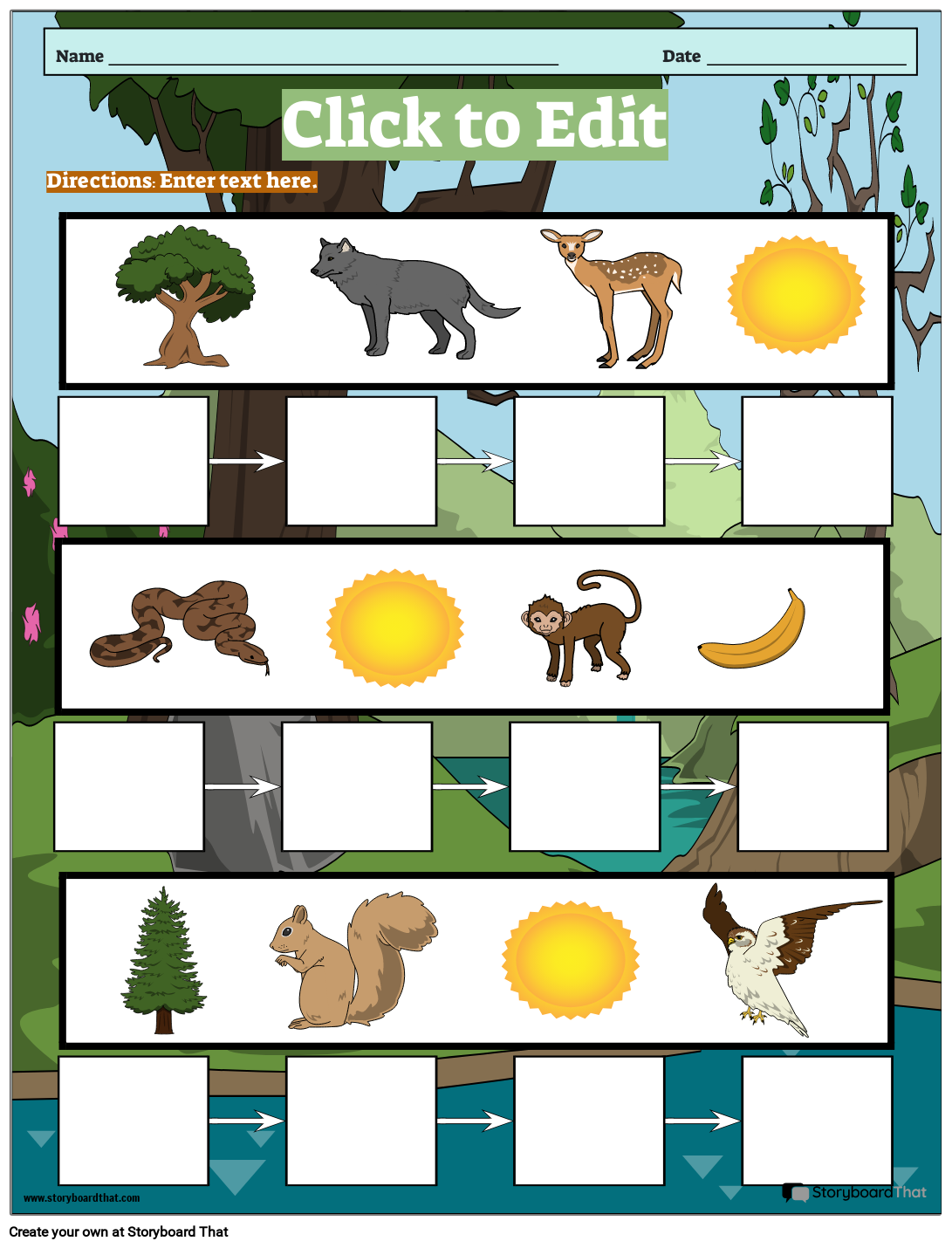Customize Food Chain Worksheets
If you're assigning this to your students, copy the worksheet to your account and save. When creating an assignment, just select it as a template!

Exploring Ecosystems: Food Chains and Food Webs Worksheets
In the intricate web of nature, where living things coexist and depend on one another for sustenance, the concept of food chains and ecosystems emerges as a fundamental pillar of understanding. It reveals the delicate balance that governs our natural world, from the humblest producers to the mightiest predators. The study of this often involves the use of educational resources like a chain, food web, and energy pyramid worksheet, enabling learners to delve into the complexities of ecological interactions and energy transfer within natural systems. Teachers often incorporate the use of food chain and webs worksheets to reinforce ecological concepts and engage students in hands-on learning about ecosystems. Blank food chains worksheets serve as versatile educational tools, enabling children to create and explore food chains in various ecological settings.
Tips to Make a Worksheet
- Define Your Learning Objectives: Begin by clearly defining the educational goals and concepts you want to cover. Consider the grade level of your students, the depth of knowledge you want to achieve, and the specific vocabulary words you want to include, such as "organisms," "consumers," and "producers". Do you want to include a word bank? An answer key?
- Choose Your Ecosystem: Decide where you want to focus on. This could be a forest, a grassland, an ocean, or any other environment. Selecting an ecosystem will help you narrow down the living things and members of the habitat you'll include in your worksheet.
- Identify Key Species: Research and identify the key species in your chosen habitat. Consider what is a producer (plants) and consumer (animals), including herbivores and carnivores. For example, if you choose grassland, you might include grass, rabbit, and fox.
- Create a Visual Representation: Design the layout of your animals food chain worksheet. You can use drawing software or hand-drawn illustrations to create a visual representation. Include pictures of the living things, labels, and arrows to indicate the flow of energy and nutrients from one species to another.
- Provide Definitions and Fill-in-the-Blanks: Incorporate comprehension-building elements. Include spaces to write definitions of key terms like "predator" and "carnivores." You can also add fill-in-the-blank questions related to the concept and trophic level.
- Add Additional Activities: Enhance the educational value of your worksheet by including additional activities. These could involve matching species to their trophic levels, vocabulary practice, creating a food web from the given food chain, or answering questions about the roles of producers and consumers. Including food chain worksheet answers allows kids to self-assess their understanding and learn from their mistakes, fostering a deeper grasp of ecological concepts.
Activity Ideas
- Explorers Workshop: Transform your classroom into interactive ecosystems where students explore and complete tailored food web worksheets to grasp the knowledge and interconnections of living things.
- Energy Pyramid Challenge Game: Engage the class in a competitive game, challenging them to arrange organism cards on an energy pyramid, reinforcing trophic levels and energy flow concepts learned from worksheets.
- Food Web Dominoes Interactive Activity: Students explore the complexity of food webs by matching organisms using food web worksheets, promoting comprehension and understanding of interconnections within ecosystems. Students use laminated dominoes featuring organisms from food web worksheets to construct interconnected food webs.
More Storyboard That Resources and Free Printables
- Food Chain Examples
- Vocabulary for Food Chains
- Creating Food Webs
- Food Chains Discussion Storyboard
- Pyramid of Numbers and Pyramid of Biomass
- Food Group Examples
How To Make a Food Chain Worksheet
Choose One of the Premade Templates
We have lots of templates to choose from. Take a look at our example for inspiration!
Click on "Copy Template"
Once you do this, you will be directed to the storyboard creator.
Give Your Worksheet a Name!
Be sure to call it something related to the topic so that you can easily find it in the future.
Edit Your Worksheet
This is where you will include directions, specific images, and make any aesthetic changes that you would like. The options are endless!
Click "Save and Exit"
When you are finished, click this button in the lower right hand corner to exit your storyboard.
Next Steps
From here you can print, download as a PDF, attach it to an assignment and use it digitally, and more!
Happy Creating!
Frequently Asked Questions about Food Chain Worksheets
What are the main components of a food chain?
A typical food chain consists of three main components: producers (plants), consumers (animals), and decomposers (organisms that break down dead organic matter). Producers make their own food through photosynthesis, while consumers obtain energy by consuming other organisms.
How does a predator-prey relationship fit into a food chain?
A predator-prey relationship is a fundamental aspect of a food chain. Predators are consumers or carnivores that hunt and eat other organisms (prey) for food. This relationship helps regulate populations and maintain balance within ecosystems.
Are there any real-world examples of disruptions in food chains?
Yes, disruptions in food chains can occur due to various factors, such as habitat destruction, pollution, invasive species, and climate change. These disruptions can lead to imbalances in the ecosystem and harm to both wildlife and humans in the community.
Introductory School Offer
ONLY$500
- 1 School
- 5 Teachers for One Year
- 1 Hour of Virtual PD
30 Day Money Back Guarantee • New Customers Only • Full Price After Introductory Offer • Access is for 1 Calendar Year
© 2025 - Clever Prototypes, LLC - All rights reserved.
StoryboardThat is a trademark of Clever Prototypes, LLC, and Registered in U.S. Patent and Trademark Office
















